Around 2500 BC in Sweden, the earliest comb was discovered, but over the generations, combs have evolved into many styles and shapes to meet various demands. Here’s a quick rundown of 11 Types of Combs and Hairbrushes and their Purpose.
Table of Contents
11 Types of Combs and Hairbrushes and their Purpose
The appropriate tools may make all the difference when it comes to getting flawless hair, but figuring out which hairbrushes you need can be difficult.
It’s critical to set aside some time each day to comb and manage your hair properly, and choosing the perfect hair comb based on your hair type is crucial. We frequently utilise one or two types of combs from our collection to maintain our hair, and changing this can drastically alter the look of your hair.
There is no such thing as the ideal sort of comb for hair that is appropriate for everyone. If someone has recommended a specific comb type for all of your needs, remember that you need to learn more about it. Indeed, there are several varieties of hair combs available for various concerns, grooming types, and selecting the appropriate one for each occasion. Let’s go over the most popular varieties of hair combs and their purposes.
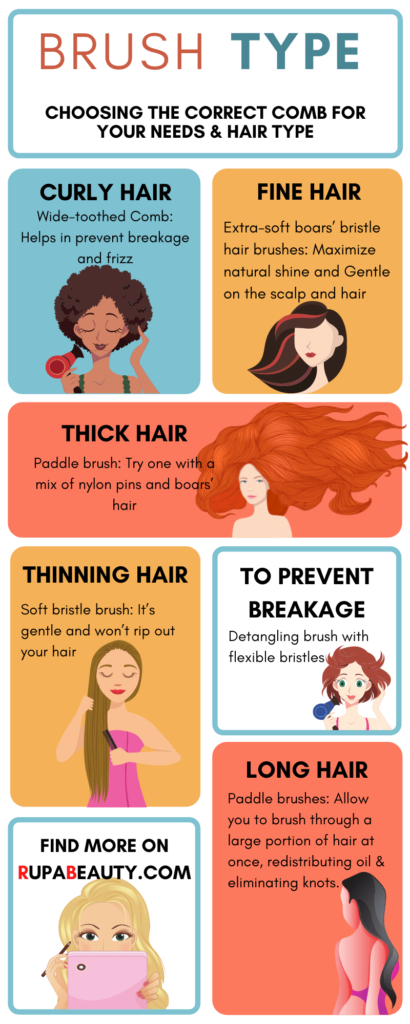
Type #1: Fine Tooth Comb
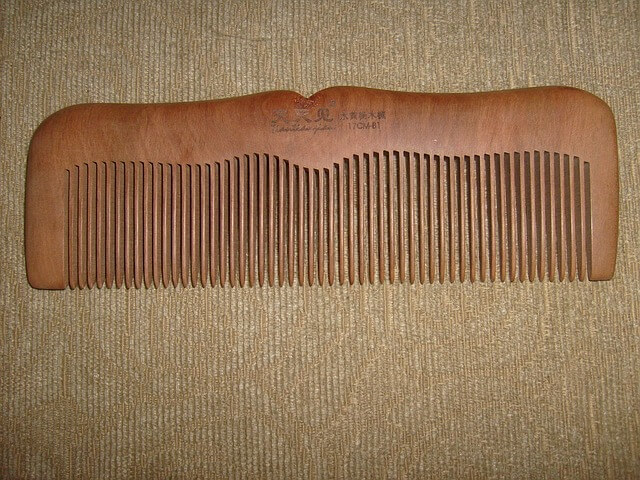
When you want to make sure all of your hair is in place, a fine-tooth comb is ideal. The teeth on this comb are close together, giving it a sleek and tidy appearance. If you have thick hair, you should avoid using a fine-tooth comb because it may not be able to get through all of it. For a neater look, it sometimes works better than a brush.
This comb is ideal for creating a precise and dignified straight hair look. However, curly, strong, thick hair is not recommended because it is prone to breakage. You can even lose your hair as a result of the stress!
Among the different types of combs for natural hair, the Fine Tooth Comb is the best.
Type #2: All Purpose Comb

All genders, children, women, and men, will benefit from the all-purpose combs. These combs have a strong design and can style both thick and thin hair well. The all-purpose comb is as versatile as its name implies, whether you desire a quick fix or a constantly stylish look.
The seven-inch comb is quite popular, probably because it is longer than most other combs, aside from the fact that it comes in a variety of colours. This comb is ideal for use at home, but there is also a smaller version that may be carried in your wallet or purse.
Type #3: Rat tail comb
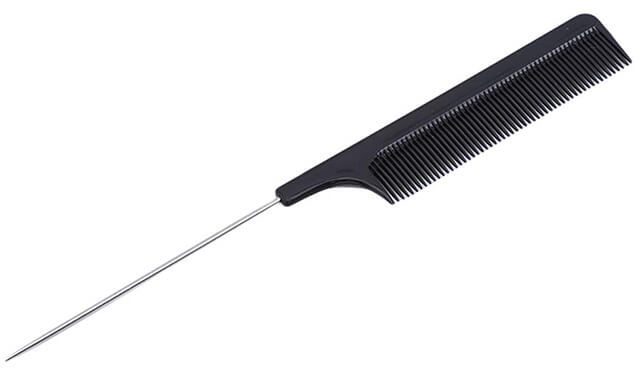
A rat-tail comb is a hair styling tool that features a sectioning tool on one end and a comb on the other. The sectioning tool is shaped like a straightened rat’s tail, hence the name. It’s mostly used for parting, sectioning, and shaping hair. It’s also used for backcombing and teasing by hairstylists, and it’s most typically utilised for chemical treatments and colouring.
The basic component of this hair styling equipment is a comb with very fine teeth and minimal space between them. The end of this kind is narrow and comes to a point at the bottom, unlike other combs that have either no handle or a straight handle. Rattail combs often have a total length of 8 inches (20.32 centimetres) to 10 inches (25.4 centimetres).
A rat-tail comb’s ability to accurately segment hair is one of its most popular uses. The comb’s end may be used to take out and separate sections of hair, making blow-drying and styling simpler. The comb is also used to make straight, flawless hair parts; it may be used to line up a part in the middle of the head or out to the side. The comb may also help you precisely draw back the head of your hair.
The rat tail comb is often used to style hair with a flat iron or curling iron. The comb’s point end may be used to pull portions of clipped hair out for style, while the comb itself can be used to smooth hair and eliminate knots before using a heat styling equipment. Heat styling may be made easier, faster, and with greater results with this type of comb.
Teasing or backcombing is perhaps the most well-known application of this type of comb. Because there isn’t much space between the comb’s teeth, you may gently press the bottom of a piece of hair towards the scalp, adding volume. This is frequently done at the crown of the head, particularly on fine-haired people. In addition, the comb may be used to add volume to ponytails and other up-dos.
While the rat tail comb is popular at home, it is a salon must-have. Chemical treatments and colour are applied to the hair using the sectioning part of the comb, which ensures that the mixture covers the hair evenly. The comb’s capacity to split off extremely small sections of hair makes it an excellent instrument for applying for hair extensions. The comb may be used to pull hairpieces through attachment tubes or to braid sewn-in extensions.
Type #4: Rake Comb
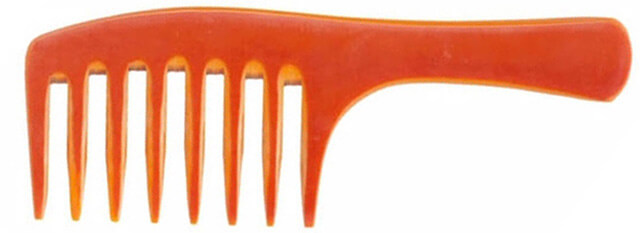
The rake comb derives its name from the wide spacing of the comb teeth and the thick texture of the teeth, which resembles a lawn rake. This comb is a lifesaver for hair that is highly knotted. It guarantees that you can comb your hair without inflicting too much pain on yourself or losing a lot of hair.
The rake comb is the perfect and the best match for women who have delicate and sensitive hair texture or hair loss and want to groom themselves with a gentle comb every day. You can detangle and comb your hair in no time, with ease and speed, and without causing any discomfort or strain to your scalp.
Type #5: Wide Tooth Comb

The most frequent and broad variation of most of the combs we’ve examined so far is the wide-tooth comb. The comb is frequently used to detangle hair and give it a thorough brushing without causing pain or discomfort. The wide-tooth comb can efficiently perform the job with minimum loss and discomfort if you have thick hair texture or even curly hair that becomes tangled and untidy easily. It is the most commonly recommended and well-known type of comb for curly hair.
Because of the huge gaps between the teeth, detangling your hair is much simpler using a broad tooth comb. This implies you’re less likely to break your hair by pulling on it. When compared to a brush or a fine-tooth comb, there is less friction, making it gentler on your hair.
When people brush their hair, they often find that it falls out more. Wide-toothed combs exfoliate the scalp and increase blood circulation while reducing hair loss.
Combs with broad teeth provide less friction than brushes and are simpler to slide through the hair. Small balls on the ends of several of them assist to untangle hair.
Brushes are harsher on your hair than wide-tooth combs and detanglers. If your hair is prone to breaking or frayed ends, smoothing out knots with a wide-tooth comb rather than a brush is less likely to create split ends.
Wide-toothed combs are ideal for wavy hair. This is due to their ability to smooth out knots while maintaining your hair’s natural curl.
When you use a standard hairbrush on curly hair, it might make it seem frizzy. The wide-tooth comb, on the other hand, leaves the hair tangle-free but wavy! One of these combs would be very useful for women with tight curls.
Type #6: Detangling Brush

While large tooth combs are helpful at eliminating knots, a detangling brush is a superior option, especially for coily hair. Fortunately, there are a plethora of options that work for various textures. The kind of bristles, the density and separation of the bristles, and, in certain circumstances, the mechanics of how the brush glides through your hair distinguish a detangling brush for curly hair from a conventional brush.
Detangling brushes are available for a variety of curly hair types. Detangling brushes for natural hair and curls should be composed of semi-flexible plastic or strong nylon bristles. The bristles should have some flex. A hard tooth on a brush may rip straight through your curls, ripping hair out in the process. Instead, carefully pick at tight knots with the brush, which should bend with the strands until the tangle is gone.
The bristles should be as evenly spaced as possible. Smoothing hair using traditional brushes with compact, tight clusters of bristles is common, as it pulls strands together. In a detangling brush, you want the polar opposite. As the brush travels through your hair, the spaced-out bristles will allow your strands to separate.
As you sweep some detangling brushes through your hair, they fan out, causing greater separation with each stroke. This brush is great for individuals with tighter curls since it dissolves knots fast and with minimum hair damage. Brushes with little balls at the ends of each tooth are also available. These go in between and break up groups of overlapping hairs, which helps to separate tough knots.
Check out the article on How to Wash Hair after applying Coconut Oil
Type #7: Cushion Brush
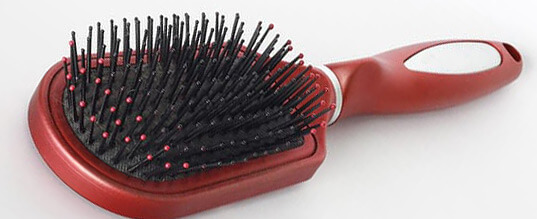
The cushion brush features an oval-shaped base with an air-cushioned surface that is commonly used by professional hairstylists. This is a great tool for regular hairstyling because of its small form and easy grip. When you have dry, knotted hair that has to be smoothed out fast, the cushion brush comes in handy.
If the bristles on your cushion brush are anti-static, it can efficiently absorb static in your hair. This sort of comb may be just what you need if your hair is prone to frizz and static.
Type #8: Round brush
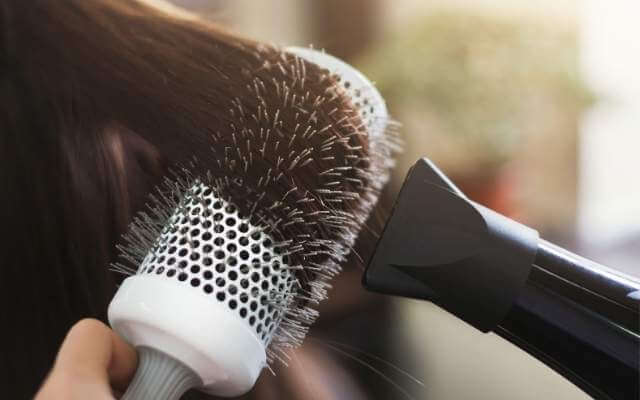
Blow drying hair and shaping loose waves with round brushes is a real treat. They’re completely round, making it simpler to blow the hair beneath and create curls or waves (depending on the size of the brush).
You can get a salon-quality blowout at home with the right round brush. The bristles’ positioning helps to control frizz and gives your hair the ideal amount of bounce. Smaller circular brushes, on the other hand, tend to produce tighter curls.
Type #9: Wet hairbrush
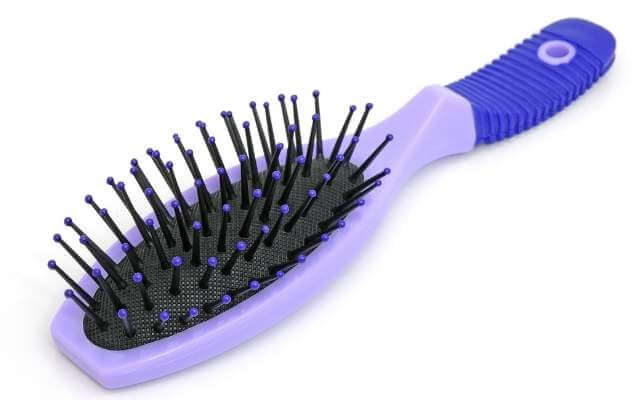
The original wet brush is a low-cost alternative. Its fine, soft bristles are powerful enough to work through the hardest knots while being gentle on damp hair. Brushing damp hair can cause breakage, according to the American Academy of Dermatology Association. Brushing wet hair is a fantastic option if you have extremely textured or curly hair. When blow-drying hair, they usually contain heat-resistant bristles that won’t melt or break.
Type #10: Boar bristle brush

Boar bristle brushes are comprised of a synthetic substance that helps to untangle thick hair and eliminates static. Some brushes mix nylon and boars’ hair bristles to decrease static and detangle while still providing the health advantages and natural shine that boars’ hair bristles provide.
Brushes with synthetic bristles are great for very thick hair. This sort of comb, unlike the natural variants, does not produce as much static. Detangling your hair will be a breeze with the stiffer bristles.
Type #11: Paddle brushes
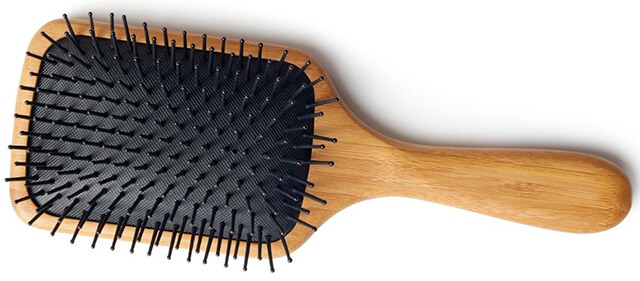
A paddle brush is a wide, flat and big hairbrush with an air-filled cushion and plastic bristles that flex and move to your head’s contours. Because of its versatility, it’s ideal for detangling and smoothing hair. It’s a must-have in every haircare kit, and it’s appropriate for all hair types, but it’s especially beneficial for long, thick, or naturally straight hair.
Polishing, smoothing, and detangling is all done using a paddle brush. Also, paddle brushes are fantastic for the winter. As lovely as all those fuzzy layers, scarves and hats are, they’re prime static-inducing materials, which is why a paddle brush is a must if you want your hair to stay smooth and frizz-free for as long as possible during the day.
Paddle brushes are great for producing smooth, straight styles on long, medium, and short hair, rather than adding volume. It’s anti-static and perfect for smoothing out frizz and flyaways, too, thanks to its flat form.
Final Word
Choosing the correct comb for your needs, hair type, and grooming style is critical to maintaining hair and scalp health. We hope you found this tutorial and information on different types of combs and brushes useful.

Creative, versatile, and passionate about her craft, Rupa Das is a well-recognized name in the world of fashion and makeup! This is a woman who has been in the fashion and makeup industry for 24 years and is still one of the leading international makeup artist in the circuit! She has worked in big brands like Lakme, Green Trends, Colors and transitioned to become a Beauty (Hair & Skin) Trainer.